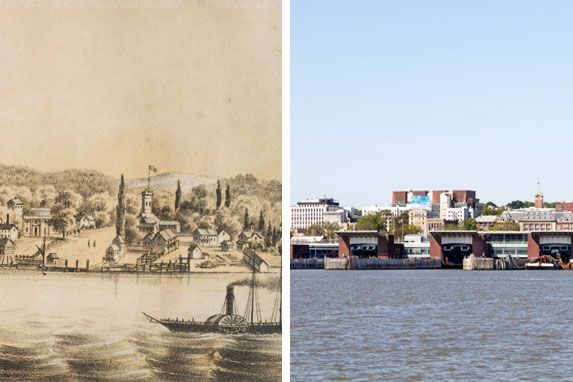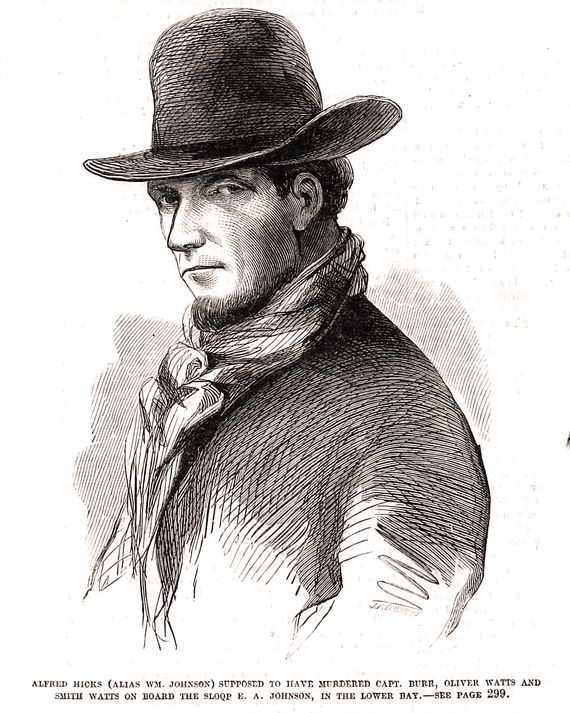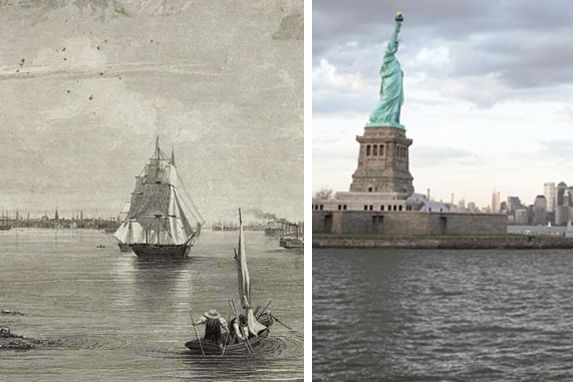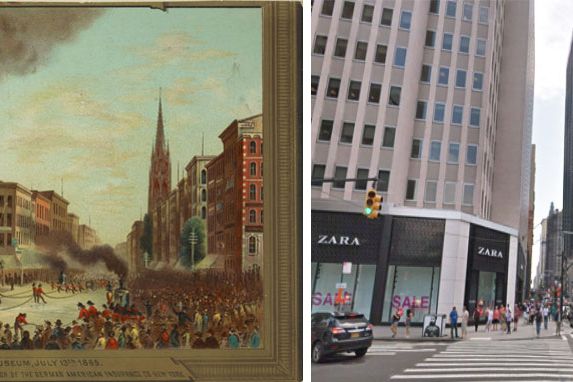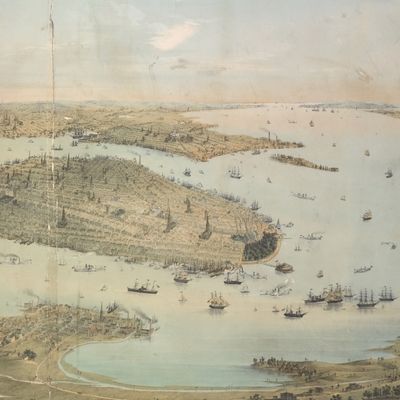
In the summer of 1860, Albert Hicks, a wayward seaman and sometime pirate who haunted the taverns on ManhattanÔÇÖs East Side docks, became the most notorious man in America. After signing on as the first mate of an oyster sloop out of the Spring Street wharf and sailing into the Lower Bay, he killed the shipÔÇÖs entire crew, dumped the bodies, stole the captainÔÇÖs money, and fled in a dinghy. Then came one of the most intense manhunts in city history. In the end, Hicks was caught, tried and convicted. He would be the last man publicly executed in New York City. It was done on BedloeÔÇÖs Island ÔÇö now Liberty Island, where the statue stands ÔÇö as 20,000 people watched, half of them from boats. By retracing the path Hicks took from Staten Island, where he beached the dinghy, to the gallows where he died, you can see both what the city was and what itÔÇÖs become. New York is a palimpsest. Everywhere you look, the old town bleeds through.
What follows are some of the places Hicks stopped as he made his getaway, accompanied by edited passages from my book The Last Pirate of New York, which is the story of the final three months in the life of the killer.
Staten Island Ferry Landing, Staten Island
The ferry terminal is now a vast complex of sheds and crowds. In 1860, it consisted of just a rimrack dock and a few sheds: a ticket office, a newsstand. Hicks came up the road in the outfit that would define him ÔÇö monkey coat and Kossuth hat, humping a sea-sack. It must have weighed something terrible, but he would not put it down or let it out of his sight. He was wild in the eyes ÔÇö not nervous, more like elated. He got there as the ferry was leaving, missed it by two minutes. Tried to run, but it was no use. He cursed something awful, stomped back and asked for a ticket for the next ship ÔÇö they left every hour. He dipped into that big bag and pulled out a heavy silver coin. He asked if there was a place to get coffee. The ticketmaster directed him to a tavern across the landing, the saloon of Peter Van Pelt, where, according to the New York Times, the fugitive ÔÇ£took refreshmentsÔÇØ and ÔÇ£ostentatiously displayed his money.ÔÇØ
129 Cedar Street
Cedar Street looked then as it looks today ÔÇö short and narrow, the sky shut out, the walls closing in. HicksÔÇÖs tenement, where he lived with his family, has been replaced by a brick slab of a building that sits beside OÔÇÖHaraÔÇÖs Pub a block west of Zuccotti Park. A two-bedroom apartment on Cedar currently goes for around $4,500 a month. Hicks paid five bucks for a bedroom and space for his child. No bath, nor running water. Just a wood stove, grim walls, and refracted light. He stopped there to pick up his family as he made his getaway, leaving behind a compass heÔÇÖd stolen from his captain ÔÇö a mistake that would be part of his undoing.
119 South Street
Currently the address of the Paris Caf├® ÔÇö established in 1873, just a few years after the pirateÔÇÖs demise ÔÇö the building, a five-story redbrick structure across from the East River, housed the Manhattan FarmerÔÇÖs & CitizenÔÇÖs Bank of Williamsburg, where Hicks had gone to exchange ÔÇö and thus launder ÔÇö his stolen money. Albert James, an officer in the bank, agreed to a trade: HicksÔÇÖs mess of mismatched bills and coins for notes unique to the bank. James recalled this encounter in court, saying that he hadnÔÇÖt had many like it ÔÇö the manÔÇÖs rough hands and excited demeanor, how he emptied the sea-sack on the desk, the racket the coins made. James said heÔÇÖd been suspicious. A merchant house had recently been robbed; thieves had gotten away with stolen silver.┬áÔÇ£Is this part of that?ÔÇØ he asked Hicks.
Hicks said he wasnÔÇÖt, but James read a different story in the pirateÔÇÖs eyes.
11 Ann Street: SweeneyÔÇÖs House of Refreshment
Ann Street is one of the oldest in the city, appearing on a map in 1728. No. 11 is currently surrounded by fancy residential buildings amid even fancier residential towers that seem to be selling old New York as a theme. In 1860, it was the site of SweeneyÔÇÖs House of Refreshment, a neighborhood joint frequented by influence peddlers who walked over from City Hall. For several years, it served as the unofficial headquarters of Isiah Rynders, a power broker and the federal marshal charged with handling Hicks. Rynders sat in the back of SweeneyÔÇÖs, telling stories, making threats, doing business. He was where you went for the Irish vote. With his gangster crew ÔÇö the Dead Rabbits ÔÇö he worked in the way of a mafia boss. (ÔÇ£The brutal and turbulent ruffian who led the mob and controlled the politics of the lower wards,ÔÇØ is how Teddy Roosevelt described him.) It was said that Rynders secured the presidency for James Buchanan in 1856. It was Buchanan who appointed Rynders federal marshal of New York.
The Tombs
The jail at 125 White Street is called the Manhattan Detention Complex, but everyone knows it as the Tombs. It replaced a jail called the Halls of Justice and House of Detention that bore the same nickname, accidentally supplied by a New Yorker named John Stephens. After he toured Egypt and then published his drawings from the trip, someone noticed that the new lockup ÔÇö it was built in 1838 ÔÇö looked like a mausoleum in the book, and the name stuck.
Twenty-two years old when Albert Hicks arrived, the Tombs was considered a vast improvement on the primitive jails it replaced. Consisting of two massive buildings, it covered the block bound by Centre Street, Elm Street (now Lafayette), Franklin Street, and Leonard Street. It was built on the shoddy fill that erased the once bucolic (and then fetid) Collect Pond.
Some said the Tombs was actually built on the island that sat at the center of that pond, the site of the cityÔÇÖs first gallows, where dozens of men, including the leaders of New YorkÔÇÖs Slave Insurrection of 1741, had been executed. Hicks became one of the most famous prisoners in the history of the jail, the occupant of Cell 8 on the so-called MurdererÔÇÖs Corridor.
Liberty Island
Marshal Rynders went out the day before to scout the island and oversee the construction of the gallows. It was really just a big rock between the upper and lower bay. Named for its first European owner, merchant Isaac Bedloe, the island had been the sight of several earlier pirate hangings. It was one of those haunted places where pirates lived and died. (Part of Captain KiddÔÇÖs treasure is said to be buried on BedloeÔÇÖs, though no one has ever found it.) Rynders chose a swell of land a few dozen yards from the beach on the east side of the island. From there, the condemned would see the entire theater of his monstrosity: Manhattan, New Jersey, Brooklyn, and the harbor.
Ann Street and Broadway: P.T. BarnumÔÇÖs American Museum
P.T. Barnum had already been operating his American Museum for nearly 20 years when Hicks was condemned. It was in a huge marble building at the corner of Ann and Broadway, across from St. PaulÔÇÖs Chapel, the oldest church in the city. It was built in 1766. If you go to that corner now, you will see a Zara and a Staples, but, back then, it was a racy street of taverns and the sort of underground gambling joints known as deadfalls or 10 percent houses. Tap Franc, the most famous, was across from the museum. It had the first roulette wheel in New York, as well as tables for faro, blackjack, and a dice game called chuck-a-luck. The museum was popular with the sort of people New Yorkers dismissed as country cousins. Barnum knew the path to their wallets by instinct, hence the never-ending stream of astonishing exhibits: the four-legged chicken and the two-headed calf, the Armless Wonder, the Wild Men of Borneo, the Fiji Mermaid ÔÇö a dead beluga whale afloat in formaldehyde ÔÇö the snake charmer, the albino, the glass-eater and the mental marvel, the ossified girl, the man who never smiles, and wax replicas of notorious outlaws and Western heroes. He asked Hicks to sit for a mask a few weeks before his execution. They quickly came to terms. Hicks got $25, two boxes of five-cent cigars, and a new suit in exchange for a casting of his face and the clothes on his back. The display went up soon after the hanging. In appeared above a placard: ÔÇ£Life-Size Wax Figure of A.W. Hicks, attired in the very clothes worn by him when he butchered his victims with an ax. Acknowledged by all to be a wonderful likeness of the infamous pirate!ÔÇØ In this way, Albert Hicks continued to dwell in Manhattan until July 13, 1865, when, eerily, on the fifth anniversary of the hanging, BarnumÔÇÖs Museum burned down. Imagine the pirate succumbing to the flames, melting ÔÇö first the nose, then the chin, then the coal-black eyes turning liquid and running like tears down the mottled face.


